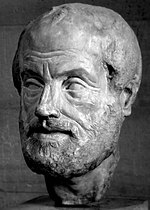Gaya

Dinafisika,gayatéh nyaéta tarikan atawa dorongan anu bisa ngabalukarkeun hiji obyék nu bogamassadiakselérasi (gerak tambah gancang atawa tambah laun).[1]Gaya bogabadagjeungarah tujuan,anu ngajadikeun gaya salaku kuantitasvéktor.NurutkeunHukum gerak Newton kadua,hiji obyék kalayanmassanu tetep bakal diakselérasi (tambah gancang atawa tambah laun gerakna]] proporsional jeung gaya bérésih (néto) anu nimpah kana éta obyék sarta babanding tibalik jeungmassana.Gaya anu nimpah kana obyék tilu diménsi bisa ogé ngabalukarkeun obyék kasebutmuteratawa ngalamandeformasi,atawa ngahasilkeun parobahantekenan.Kacondongan hiji gaya pikeun ngabalukarkeun puteran (akselerasi sudut) sabudeureun hiji sumbu disebuttorsi.Deformasi jeung tekenan mangrupa hasil tina gaya-gayastrésdina jero hiji obyék.[2][3]
|
|
Artikel ieu keur dikeureuyeuh,ditarjamahkeuntinabasa Inggris. Bantuanna didagoan pikeunnarjamahkeun. |
Since antiquity, scientists have used the concept of force in the study ofstationaryandmovingobjects. These studies culminated with the descriptions made by the third century BC philosopherArchimedesof howsimple machinesfunctioned. The rules Archimedes determined for how forces interact in simple machines are still a part of physics.[4]éarlier descriptions of forces byAristotleincorporated fundamental misunderstandings which would not be corrected until the seventeenth century byIsaac Newton.[3]Newtonian descriptions of forces remained unchanged for néarly three hundred yéars.
Current understanding ofquantum mechanicsand thestandard modelofparticle physicsassociates forces with thefundamental interactionsaccompanying the emission or absorption ofgauge bosons.Only four fundamental interactions are known: in order of decréasing strength, they are:strong,electromagnetic,weak,andgravitational.[2]High-energy particle physicsobservationsmade during the 1970s and 1980s confirmed that the wéak and electromagnetic forces are expressions of a unifiedelectroweakinteraction.[5]Einsteinin histheory of general relativityexplained that gravity is an attribute of thecurvatureofspace-time.
Pre-Newtonian concepts
[édit|édit sumber]
Since antiquity, the concept of force has been recognized as integral to the functioning of éach of thesimple machines.Themechanical advantagegiven by a simple machine allowed for less force to be used in exchange for that force acting over a gréater distance. Analysis of the characteristics of forces ultimately culminated in the work ofArchimedeswho was especially famous for formulating a tréatment ofbuoyant forcesinherent influids.[4]
Aristotleprovided aphilosophicaldiscussion of the concept of a force as an integral part ofAristotelian cosmology.In Aristotle's view, thenatural worldheldfour elementsthat existed in "natural states". Aristotle believed that it was the natural state of objects with mass onEarth,such as the elements water and éarth, to be motionless on the ground and that they tended towards that state if left alone. He distinguished between the innate tendency of objects to find their "natural place" (e.g., for héavy bodies to fall), which led to "natural motion", and unnatural or forced motion, which required continued application of a force.[6]This théory, based on the everyday experience of how objects move, such as the constant application of a force needed to keep a cart moving, had conceptual trouble accounting for the behavior ofprojectiles,such as the flight of arrows. The place where forces were applied to projectiles was only at the start of the flight, and while the projectile sailed through the air, no discernible force acts on it. Aristotle was aware of this problem and proposed that the air displaced through the projectile's path provided the needed force to continue the projectile moving. This explanation demands that air is needed for projectiles and that, for example, in avacuum,no projectile would move after the initial push. Additional problems with the explanation include the fact thatair resiststhe motion of the projectiles.[7]
These shortcomings would not be fully explained and corrected until the seventeenth century work ofGalileo Galilei,who was influenced by the late medieval idéa that objects in forced motion carried an innate force ofimpetus.Galiléo constructed an experiment in which stones and cannonballs were both rolled down an incline to disprove theAristotelian theory of motionéarly in the seventeenth century. He showed that the bodies were accelerated by gravity to an extent which was independent of their mass and argued that objects retain theirvelocityunless acted on by a force, for examplefriction.[8]
Newtonian mechanics
[édit|édit sumber]Isaac Newtonis the first person known to explicitly state the first, and the only, mathematical definition of force—as the time-derivative of momentum:.In 1687, Newton went on to publish hisPhilosophiae Naturalis Principia Mathematica,which used concepts ofinertia,force, andconservationto describe the motion of all objects.[3][9]In this work, Newton set out three laws of motion that to this day are the way forces are described in physics.[9]

References
[édit|édit sumber]- ↑"glossary".Earth Observatory.NASA.Diakses tanggal2008-04-09.
Force: Any external agent that causes a change in the motion of a free body, or that causes stress in a fixed body.
Archived2008-10-12 diWayback Machine - ↑abe.g.Feynman, R. P., Leighton, R. B., Sands, M. (1963).Lectures on Physics, Vol 1.Addison-Wesley.;Kleppner, D., Kolenkow, R. J. (1973).An introduction to mechanics.McGraw-Hill..
- ↑abcUniversity Physics,Sears, Young & Zemansky, pp18–38
- ↑abHeath,T.L."The Works of Archimedes(1897). The unabridged work in PDF form (19 MB) ".Archive.org.Diakses tanggal2007-10-14.
- ↑Salah ngutip: Tag
<ref>tidak sah; tidak ditemukan teks untuk ref bernamafinal theory - ↑Land, HelenThe Order of Nature in Aristotle's Physics: Place and the Elements(1998)
- ↑Hetherington, Norriss S. (1993).Cosmology: Historical, Literary, Philosophical, Religious, and Scientific Perspectives.Garland Reference Library of the Humanities. p. 100.ISBN0815310854.
- ↑Drake, Stillman (1978). Galileo At Work. Chicago: University of Chicago Press.ISBN 0-226-16226-5
- ↑abNewton, Isaac(1999).The Principia Mathematical Principles of Natural Philosophy.Berkeley: University of California Press.ISBN0-520-08817-4.This is a recent translation into English by I. Bernard Cohen and Anne Whitman, with help from Julia Budenz.
Bibliography
[édit|édit sumber]- Corbell, H.C.; Philip Stehle (1994).Classical Mechanics p 28,.New York: Dover publications.ISBN 0-486-68063-0.
- Cutnell, John d.; Johnson, Kenneth W. (2004).Physics, Sixth Edition.Hoboken, NJ: John Wiley & Sons Inc.ISBN041-44895-8Check
|isbn=value (bantuan). - Feynman, R. P., Leighton, R. B., Sands, M. (1963).Lectures on Physics, Vol 1.Addison-Wesley.ISBN 0-201-02116-1.
- Halliday, David; Robert Resnick; Kenneth S. Krane (2001).Physics v. 1.New York: John Wiley & Sons.ISBN 0-471-32057-9.
- Parker, Sybil (1993).Encyclopedia of Physics, p 443,.Ohio: McGraw-Hill.ISBN 0-07-051400-3.
- Sears F., Zemansky M. & Young H. (1982).University Physics.Reading, MA: Addison-Wesley.ISBN 0-201-07199-1.
- Serway, Raymond A. (2003).Physics for Scientists and Engineers.Philadelphia: Saunders College Publishing.ISBN 0-534-40842-7.
- Tipler, Paul (2004).Physics for Scientists and Engineers: Mechanics, Oscillations and Waves, Thermodynamics(5th ed. ed.). W. H. Freeman.ISBN 0-7167-0809-4.
- Verma, H.C. (2004).Concepts of Physics Vol 1.(2004 Reprint ed.). Bharti Bhavan.ISBN 81-7709-187-5.



